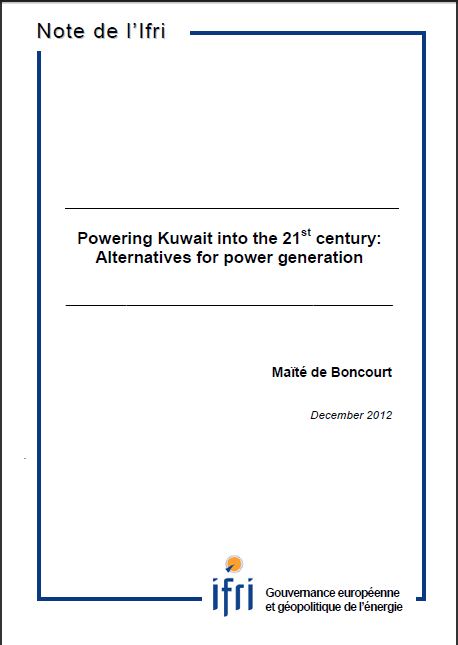Powering Kuwait into the 21st Century: Alternatives for Power Generation

Kuwait is facing a surge in the consumption of power. The current power fuel mix, based on oil, appears unsustainable. Yet Kuwait has a large number of assets.
The power fuel mix can be optimized and diversified to include alternatives to oil such as gas or renewables, so as to benefit from the opportunity cost of oil (the price at which this oil could be sold on international market). The country has gas reserves and a good potential in renewable technologies. If energy efficiency can be considered as a potential resource, then much can be achieved in this area as well, given Kuwait’s current power and water per capita consumption rates, which are among the highest in the world.
The present tendency has been to go for step-by-step fixes, adding emergency power plants which have increased power generation costs and a non optimized system. Kuwait is on the verge of defining a new power fuel mix, with more gas, and developing new R&D projects.
In this context, this memorandum looks at alternatives, and concludes that in the long term a diversified power mix has to be developed. The current gas glut at the world level, resulting both from the production of unconventional gas resources and the economic recession hitting Europe, offers a sizable opportunity for gas imports. A transition strategy for the power sector could make use of gas imports. In the longer term, however, Kuwait should not make a one-way bet and develop its domestic gas resources. This paper urges the adoption of a common gas strategy integrated into a power sector strategy, through consultation with all actors. It would include reserves, costs, feasibility and potential uses, as well as economic opportunities.
As the region is facing gas shortages and Kuwait ranks independency of supply among its policy priorities, renewable, and in particular solar have their own place in the power mix. The country indeed disposes of substantial and relatively predictable renewable energy resources. Those are well fitted to Kuwait’s electricity consumption patterns. They can first contribute to peak demand and seasonal variations shaving. In the medium term, dedicated applications and distributed (such as Building Integrated Photovoltaic, solar cooling etc.) could also help to relieve the power system of residential and air conditioning load. Power price subsidies for consumers will block their development. The drafting of policies will actually be decisive to ensure the roll out and the sustainability of renewable power. The current 10% renewable target still remains to be defined. Finally, the building of an industry to diversify the economy appears more challenging.
Nuclear power plants projects have been scrapped by the government for security reasons despite the competitiveness of this technology and the availability of liquid funds. The country hopes to import electricity from its neighbors, which will soon benefit from this technology. The creation of a regional electricity market could help to decrease costs, increase the security of power supply, and lead to an optimization of national power systems. However, the size of interconnections is too small and legislation about electricity trade still incomplete. Regional integration would require price reforms at some point, or at least a clear evaluation of costs. Multiple prices and costs, inside Kuwait and across the region, act as a significant bottleneck.
Whatever the choices made, the sustainability of the system cannot be achieved without an underlying energy efficiency strategy. This strategy needs to focus on both the consumption and production side and rely on a clear cost-benefit analysis to serve the interest of the country.

Available in:
Regions and themes
ISBN / ISSN
Share
Download the full analysis
This page contains only a summary of our work. If you would like to have access to all the information from our research on the subject, you can download the full version in PDF format.
Powering Kuwait into the 21st Century: Alternatives for Power Generation
Related centers and programs
Discover our other research centers and programsFind out more
Discover all our analysesBrazil One Year Away from the October 2026 General Elections
Brazil’s general elections will be held on October 4, 2026, to elect the president, vice-president, members of the National Congress, governors, deputy governors and state legislative assemblies. For the presidential and gubernatorial elections, a second round will be held on October 25 if no candidate obtains a majority of the votes in the first round.
COP30: An Inflection Point for Climate Action and Governance
The 30th Conference of the Parties (COP30), opening in Belém, Brazil, on November 10th 2025, convenes at a perilous moment.
The Strategic Dimension of Skills in the Clean Industrial Deal
In the competitiveness and energy transition battles, the European Union (EU) must master a determinant factor: skills.
The Energy Transition Faces Geopolitical Challenges. How Can Ideological Divides Be Overcome?
President Trump’s positions and policies, combined with record coal consumption and booming global electricity demand, geo-economic confrontation, and widespread concerns about energy security, are changing the game when it comes to understanding realistic decarbonization trajectories. The war in Europe is intensifying competition between defense and transition budgets. This is also the case elsewhere in the world.










